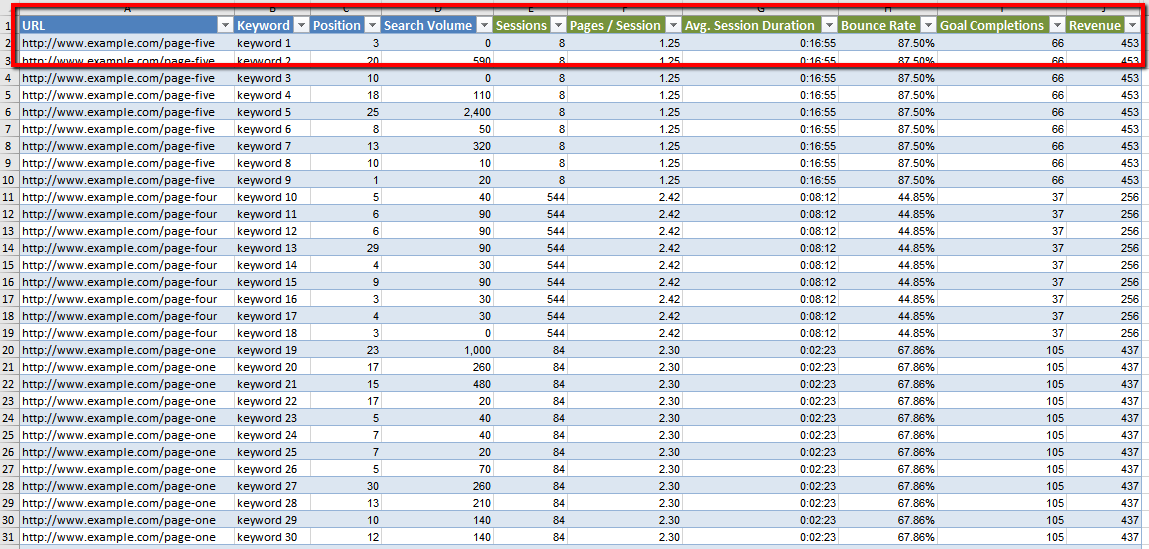By David Portney, Sr. SEO Manager
In my last blog post, “3 SEO Mistakes You’re Probably Making”, one of them was focusing on the wrong goals.
I said it’s a mistake to make knee-jerk reactions to the not-uncommon demand, “I want page x to rank for a, b, and c keywords.” And, I promised to provide you a process to get a much more layered, nuanced, and accurate view of your keyword landscape, which can show you what you should actually be prioritizing when doing on-page optimization work.
I’m referring to this process as keyword mapping. But, what we’re not going to do is the kind of keyword mapping where we look at a page, read its content, do some keyword research, then assign primary and secondary keywords to that page. There’s nothing wrong with that process per se when performed by seasoned SEO experts; we’re just going to come at this from a different (and I think better) angle.
You can still assign keywords to pages if you want with this process, but if you do you’ll be doing it with far better information at your fingertips.
Here’s a summary of key benefits of this keyword mapping process:
- Getting to reality vs. “I want this page to rank for XYZ keywords”
- Find the SEO low-hanging fruit
- Identify longer-term optimization efforts
- Identify keyword cannibalization
- Identify content opportunities and gaps
- Recover (not provided) keyword data (sort of)
This is a tried-and-true keyword-to-page mapping process that eliminates guesswork and allows you to make data-driven decisions based on facts – not wishes or wants.
This keyword mapping process consists of 4 distinct steps:
- Keyword mining
- Keyword expansion
- Keyword analysis
- Keyword metrics
What’s also cool about this process is that you’ll be able to tie this data into your Analytics engagement and conversion metrics, giving you a very detailed picture of how your site is performing, and showing you the SEO path forward.
Keyword Mapping Step 1: Keyword Mining
Keyword mining is about getting as much keyword data about your site as you possibly can.
Note that I said “about your site.” That means you have an existing site. If you don’t, you’re going to need a different process. That’s a different blog post I may write, if there’s enough demand. (Ahem.)
In this step of the keyword mining process, you’ll pull keyword data about your site from the following tools:
- Google Search Console – get query data from the Search Analytics section
- Google Analytics
Note: if your business model hasn’t changed much in the last 5 years, you can go back before (not provided) became a thing and export keyword data that drove traffic to your site - Google Analytics – grab the AdWords Search Queries data
- Google Analytics – if you have site search enabled, download Site Search Terms data
- Bing Webmaster Tools
So far, so good. Now plug your website into the following tools and extract all of the organic keyword data:
- SearchMetrics
- SEMrush
- Ahrefs
- SpyFu
- Google Keyword Planner (get the keyword ideas and the ad group data too)
Combine all of these keywords in a single sheet in Excel, or use Google Sheets or your favorite spreadsheet program. You can de-duplicate the list now or wait until later. I also like to create a column “source” in case I later wonder where the heck that keyword came from.
Keyword Mapping Step 2: Keyword Expansion
Every business owner or VP of Marketing or Director of Getting More Leads & Sales has a pet keyword or 5. Those pet keywords are typically keywords that matter most to them
Take note: those pet keywords of yours might not be the keywords that your target market searches on Google for your offering – that’s a different problem for you to consider. Let’s assume you don’t have that problem, and that you’ve got 5-10 highly relevant keywords that matter most to you and your business.
In the keyword expansion step, you’re going to plug each of those keywords, one by one, into the following tools and export lists of related keywords:
Again – one by one – plug each of your pet (relevant, important) keywords into the following tools, and export the related keywords you find:
- Google (scroll to the bottom, grab the “searches related to”)
- Google Trends – related queries
- Ubersuggest.io
- Keywordtool.io
- SearchMetrics
- SEMrush
- Moz Keyword Explorer
- Ahrefs
- SpyFu
- Aaron Wall’s SEObook keyword tool
- LSI Graph Keyword Generator
- Metaglossary.com
- Soovle.com
- AnswerThePublic.com
If you’re not familiar with some of those tools, a quick Google search will uncover them easily.
There are two more things you should do in the keyword expansion step:
- One by one, search your pet keyword on Wikipedia. Then, take that Wikipedia page URL and pop it into SEMrush and the Google Keyword Planner Tool. Export yet more keywords to add to your Excel sheet.
- Put your competitor’s website into SearchMetrics & SEMrush, etc., and grab your competitors’ keywords too!
Now you should have quite a lot of keywords, and you’re ready for step 3.
Keyword Mapping Step 3: Keyword Analysis
All keywords are not created equal.
Keyword analysis means you’re going to need to categorize and classify each keyword.
Here are some possibilities for classifying your list of keywords:
- Brand vs. non-brand
- Relevance – (1, 2, 3, x)
- Importance – (1, 2, 3, x)
- Logical category type – (model, make, color, condition, whatever)
- Funnel level – (high, mid, low)
- Query type – know, go, do (informational, navigational, transactional)
- Commercial intent (high, mid, low)
- Difficulty
- Whatever matters to you and your business
You don’t have to use all of those. Maybe funnel level matters most to you. Maybe it’s a subjective ordering of importance. Maybe it’s commercial intent. I can’t decide that for you – but you have to pick at least one way of determining which keywords are more important than other keywords.
Here’s a visual on how it might look if you decided to use several methods of categorizing your keywords:

Keyword Mapping Step 4: Keyword Metrics
Let’s recap: at this point you should have a lot of keywords based on keyword mining and keyword expansion, and you’ve analyzed them and classified them.
The last step in creating your keyword map is obtaining some important metrics associated with those keywords.
Take your list of keywords and plug them into your favorite rank tracking tool.
Here’s are some you could use (there are others as well; I don’t judge):
- Advanced Web Ranking
- SearchMetrics
- SERPs
- Authority Labs
- STAT
- Whatever your favorite tool is
After you run your keywords in your favorite rank tracker tool, make sure you export the following bits of keyword-associated data, at a minimum:
- Keyword ranking position
- Keyword search volume
- Ranking page for each keyword
Finally, export an organic landing page report from Google Analytics along with engagement metrics and conversion metrics. Stitch all the data together using some Excel wizardry, and you’ll have something resembling this:

Then with just a tad bit more Excel wizardry you can pivot the data, add some conditional formatting, and get something like this:

Now you have keyword data on a per-page basis.
- You can find pages with keywords ranking in “striking distance” (bottom of Google page 1 or on page 2) and look to boost them up in the rankings. That’s your low-hanging fruit.
- You can find pages with keywords that are ranking beyond page 1-2 of Google – those are your secondary optimization efforts.
- You can find keywords ranking on 2 or more pages – that’s keyword cannibalization for you to fix.
Now you can make data-driven decisions, rather than operating in the dark or guessing.
As I said in the beginning – you can just assign primary and secondary keywords to pages based on your experience, intuition, and knowledge, but it’s my opinion and experience that you’ll be far better off doing so once you’ve completed this process and arrived at reality.
Conclusion
This keyword mapping process is a lot of work. You probably said that to yourself several times while reading this article. But it’s worth the effort because you eliminate guesswork and are able to identify and prioritize optimization efforts based on data, not hunches or guesses or wishes or wants. Plus, you’ll gain a tremendous amount of information about this niche or vertical, especially if it’s a business model with which you’re not already familiar. This is true data-driven, clarity-based SEO that will serve you greatly if you’re willing to make the effort.






